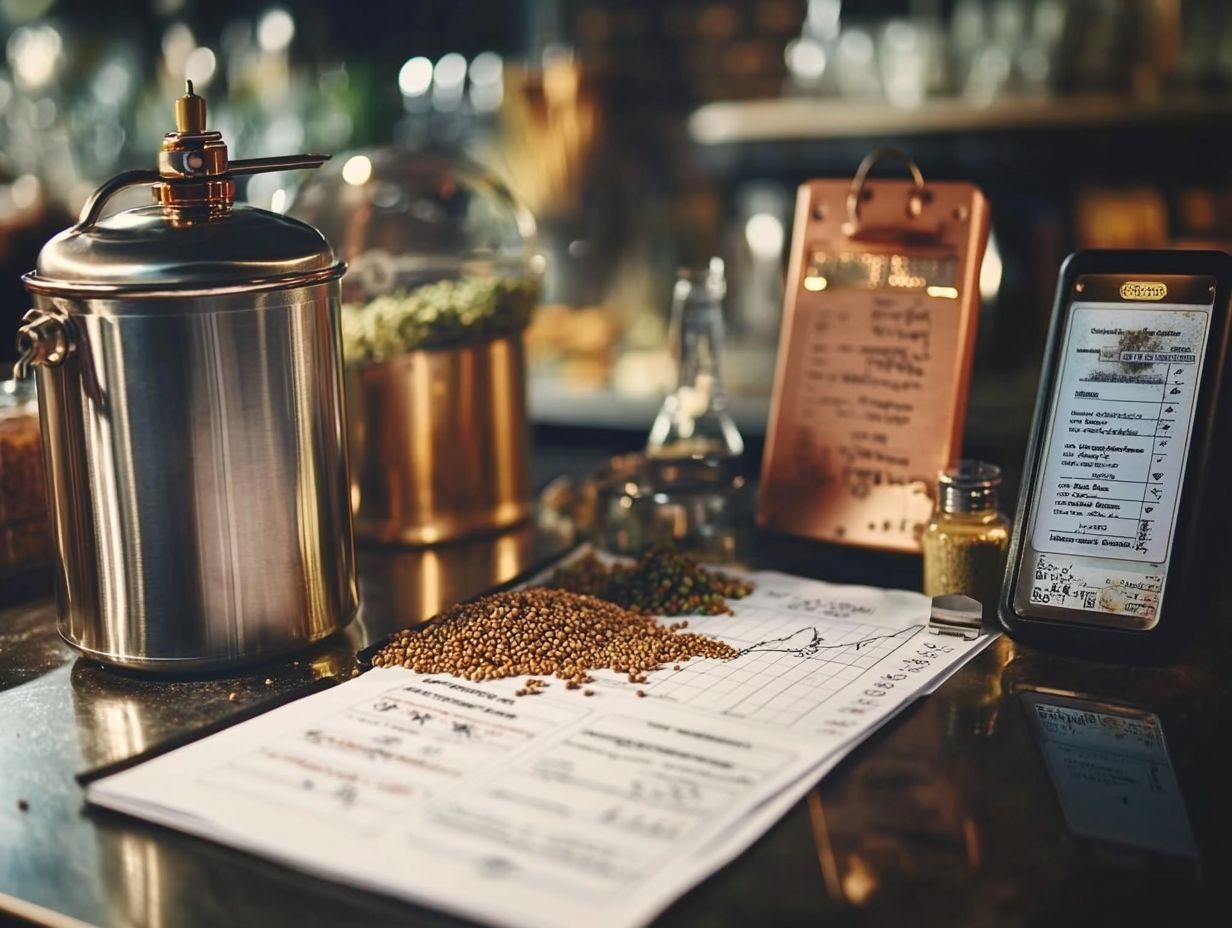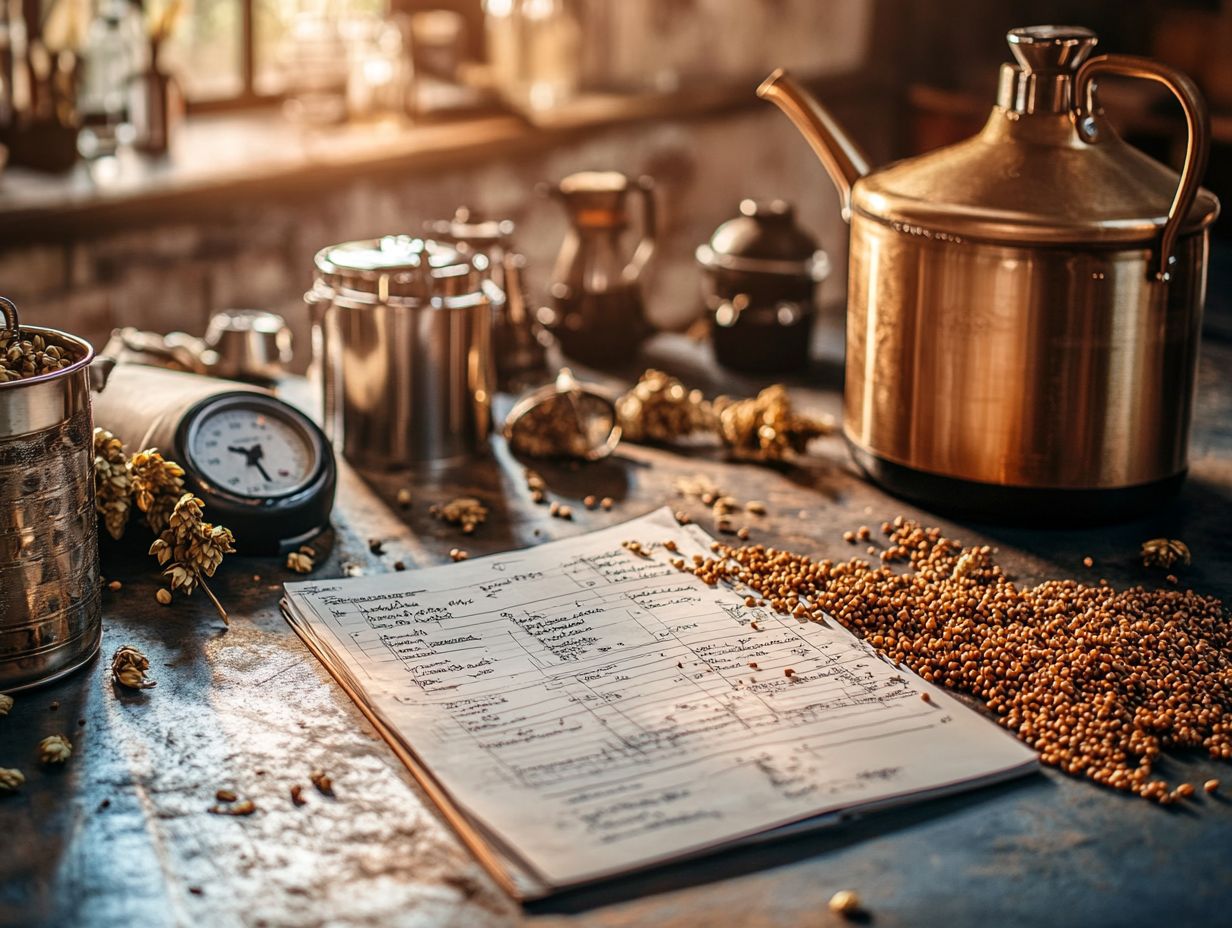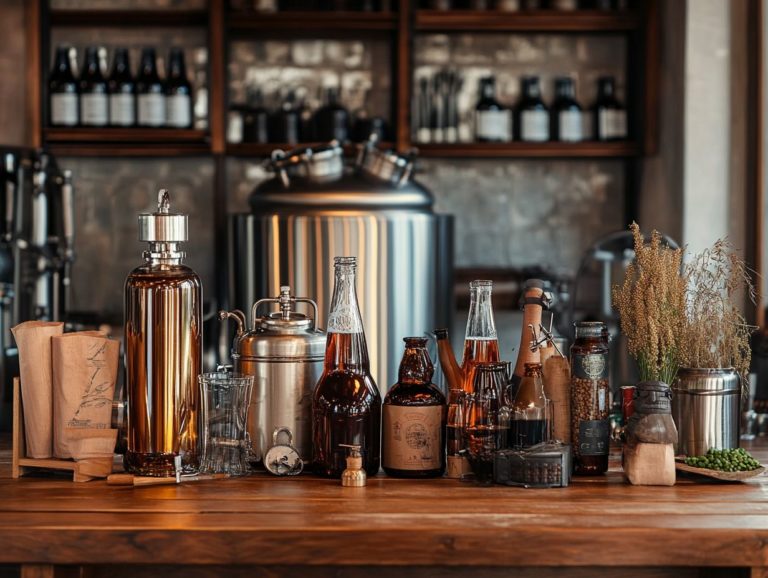5 Common Mistakes with Brewing Equipment
Brewing the perfect cup of coffee or beer is truly an art form, yet even the most seasoned coffee aficionados and homebrewers can stumble into common mistakes that detract from flavor and quality.
From neglecting proper cleaning of your equipment to selecting the wrong grind size, these common pitfalls can transform what should be a delightful brewing experience into a rather frustrating endeavor. Poor-quality water and improper fermentation temperature are also significant issues.
This article will shine a light on five key mistakes to avoid, provide you with essential tips for maximizing the effectiveness of your brewing equipment, and answer your burning questions about achieving that elusive perfect brew.
Prepare yourself to elevate your coffee game to new heights!
Contents
- Key Takeaways:
- 1. Not Cleaning Equipment Properly
- 2. Using the Wrong Water Temperature
- 3. Using the Wrong Grind Size
- 4. Not Measuring Accurately
- 5. Not Following Instructions
- What Are the Essential Brewing Equipment for Coffee?
- Essential Brewing Tools
- What Are the Key Factors to Consider When Choosing Brewing Equipment?
- How Can One Properly Clean Brewing Equipment?
- What Are the Common Mistakes to Avoid When Using Brewing Equipment?
- What Are Some Tips for Getting the Best Brew with Brewing Equipment?
- How Can One Troubleshoot Common Issues with Brewing Equipment?
- Frequently Asked Questions
- What are the 5 common mistakes people make with brewing equipment?
- How do I prevent my equipment from getting dirty?
- Why is it important to properly sanitize brewing equipment?
- What should I do if my ingredients have expired?
- Why is using the correct measurements important in brewing?
- What can happen if I don’t follow proper brewing techniques?
Key Takeaways:

- Not cleaning brewing equipment properly can affect the taste and quality of your coffee or beer. Regularly clean and sanitize your equipment to ensure a better brewing experience.
- The water temperature is crucial for brewing the perfect cup of coffee or beer. Using water that is too hot or too cold can result in a bitter or weak tasting brew, affecting yeast health and the fermentation process in beer.
- Grind size plays a significant role in the taste of your coffee. Using the wrong grind size can lead to under-extracted or over-extracted coffee, resulting in a less than ideal cup.
1. Not Cleaning Equipment Properly
Not properly cleaning your equipment is one of the most significant blunders you can make as a homebrewer. This oversight can lead to unsanitary tanks that ruin the fermentation process and ultimately compromise the quality of your beer. To maintain yeast health and achieve the best results in your homebrewing ventures, it’s essential to meticulously clean and sanitize all your brewing equipment. Always use proper cleaning solutions and follow best practices for cleaning and sanitizing.
Neglecting proper cleaning can leave behind residual sugars and bacteria that feed on the yeast, resulting in off-flavors and an unbalanced brew. Unsanitary conditions can encourage the growth of wild yeast and unwanted microorganisms, which could spoil a batch or even compromise your entire brewing setup.
For effective cleaning, consider using oxygen-free cleaning solutions specifically designed for brewing, like non-foaming caustic cleaners, as well as reliable sanitizers such as Star San or iodine-based products. Adopting best practices like cleaning immediately after use and regularly inspecting your equipment will significantly bolster your chances of brewing success.
A clean brewing environment not only safeguards your beer but also enhances your overall brewing experience.
2. Using the Wrong Water Temperature
Using the correct water temperature is essential in the brewing process, as it can profoundly impact the overall quality of your beer, especially during fermentation, where maintaining the right temperature is critical for optimal yeast performance. Improper temperature control is a common cause of fermentation mistakes.
As a brewing enthusiast, you should pay careful attention to the ideal temperatures for various stages. Mashing should occur around 150-165 F to effectively convert starches into sugars, while fermentation typically ranges from 60-72 F, depending on the yeast strain you re using.
Even slight temperature fluctuations can stress the yeast, leading to off-flavors and altered aroma profiles that could compromise your brew. To ensure consistency, it s wise to invest in a fermentation chamber or a temperature-controlled space. This will help in maintaining a proper fermentation schedule and optimal fermentation temperatures.
By diligently monitoring your brewing environment and employing proper insulation, you can minimize temperature variations and ultimately produce a more balanced and flavorful beer.
3. Using the Wrong Grind Size
The grind size of your grains is a pivotal factor in the brewing process. Using the incorrect grind size can hinder the efficient extraction of sugars, ultimately affecting both the wort aeration, the flavor profile, and the alcohol content of your final beer. Proper grinding is also essential for achieving desired clarity and mouthfeel in your beer.
This delicate balancing act underscores the importance of understanding how various grind sizes can influence extraction efficiency. For example, finer grinds typically enhance the release of sugars and flavors, yet they can also lead to over-extraction and unwanted bitterness, particularly in brewing methods like espresso. On the other hand, coarser grinds can facilitate better flow rates and minimize sediment, but they may necessitate longer steeping times in techniques such as cold brewing to fully unlock the aromatics and flavors.
Selecting the right grind size for each brewing method is essential, as it directly impacts not only the taste but also the clarity and mouthfeel of your beer. Consistency in grind size is crucial; even small fluctuations can result in unpredictable outcomes, jeopardizing both the quality and repeatability of your brewing endeavors.
4. Not Measuring Accurately

Accurate measurement is paramount in homebrewing; neglecting to measure your ingredients precisely can lead to flawed gravity readings, which ultimately impacts both fermentation management and the final outcome of your brew recipes. Utilizing a reliable brewing scale will help ensure that all measurements are precise and consistent.
The precision in measuring ingredients not only dictates the alcohol content but also shapes the overall flavor profile of your creation. Employing a brewing scale can significantly enhance your accuracy, ensuring that each ingredient is added in the correct proportions.
Inaccuracies can lead to a brew that tastes overly bitter or excessively sweet, leaving even the most experienced brewers feeling let down. To achieve consistency in your homebrewing efforts, consider the following steps:
- Calibrate your scale regularly.
- Use the same measuring tools for each batch.
- Keep detailed notes on every brew process.
By focusing on these essential details, you can craft more reliable and enjoyable homebrew experiences that truly satisfy your palate.
5. Not Following Instructions
When you fail to follow instructions while brewing, you open the door to a host of potential issues, ranging from minor flavor inconsistencies to outright brewing disasters. Understanding the importance of sticking to the fermentation schedule and employing proper brewing techniques is essential for crafting a quality craft beer.
These guidelines form the backbone of a successful brewing process, providing a structured approach that minimizes the risks often associated with improvisation. Brewers who choose to disregard these instructions frequently encounter problems like off-flavors, undesirable aromas, or even complete fermentation failures.
By closely adhering to the recipe taking care with ingredient measurements, fermentation times, and temperature controls you can ensure a consistent and enjoyable final product. Following established brewing protocols not only facilitates better tracking and replication of successful batches but is also crucial for anyone looking to refine their craft and produce exceptional beer that truly resonates with drinkers.
What Are the Essential Brewing Equipment for Coffee?
Essential Brewing Tools
To brew coffee effectively, you need the right equipment. Tools like grinders, brewing vessels, and filters simplify the process and enhance the flavor.
Investing in a high-quality burr grinder ensures uniform grinding. This leads to better extraction and a more balanced taste.
Brew vessels such as French presses, pour-over setups, or espresso machines provide unique methods that highlight distinct flavor profiles. Filters are important because they provide clarity and prevent sediment in your brew.
Equally crucial is the maintenance of these tools. Regular cleaning and sanitizing are necessary, as residual oils and coffee residues can spoil the taste of your future brews.
Ready to innovate? Experimenting with techniques like cold brewing or exploring the world of siphon brewers can unlock exciting flavors and transform your coffee ritual into an art form.
What Are the Key Factors to Consider When Choosing Brewing Equipment?
When selecting brewing equipment, several key factors must be considered, such as the type of beer, the scale of your brewing operation, and the specific techniques you plan to employ each of these will significantly influence your choice of gear.
The capacity of the equipment is crucial; it should align with your production goals, whether you’re brewing small batches at home or gearing up for commercial distribution.
The material of the equipment also plays a vital role in your decision-making process. Stainless steel, like Craftmaster Stainless, is often preferred for its durability and ease of cleaning, while glass might offer intriguing benefits for smaller, experimental setups.
Ease of use is another important aspect, particularly if you re just starting out. A user-friendly design can make a world of difference.
For instance, an electric all-in-one brewing system could be ideal for those seeking convenience, while a traditional three-vessel system might attract experienced brewers who desire greater control over their processes.
By understanding these factors, you can choose equipment that aligns with your brewing ambitions. Whether a hobbyist or a seasoned brewer, avoiding the five common mistakes in brewing coffee and selecting the right tools will enhance your experience.
How Can One Properly Clean Brewing Equipment?

To achieve optimal brewing results, it’s essential that you clean and sanitize all your brewing equipment thoroughly. Using the right cleaning solutions and techniques will help prevent contamination and ensure the quality of your beer remains top-notch. This is particularly important when dealing with brewing enthusiasts who often experiment with new techniques and recipes.
Begin the process with a thorough rinse to remove any residues from previous brews. A mix of hot water and a recommended brewery-specific cleaning agent, such as an alkaline cleaner (a type of cleaning solution that helps to break down grease and other organic materials), works wonders for degreasing and eliminating organic materials. Remember, using a proper cleaning solution is key to maintaining your brewing equipment.
After scrubbing the equipment, let it soak for a specified period to enhance the cleaning agent’s effectiveness. Once that’s done, rinse again to make sure no traces of cleaning solution remain.
The sanitization stage is equally crucial. Utilize items like iodine (a no-rinse sanitizer) or other no-rinse sanitizers to eliminate any lingering bacteria or wild yeast. It’s also important to avoid unsanitary tanks to ensure the quality of your brew.
By committing to regular maintenance, you not only extend the lifespan of your equipment but also ensure consistently high-quality beer production. These cleaning routines are vital for anyone passionate about brewing, whether you’re a novice or a seasoned professional. Embracing best practices in cleaning and sanitizing will make your brewing process more efficient. Imagine the thrill of tasting your best brew yet, all thanks to your meticulous cleaning efforts!
What Are the Common Mistakes to Avoid When Using Brewing Equipment?
When using brewing equipment, it s essential to recognize several common mistakes that can undermine the quality of your beer. By being aware of these pitfalls, you can sidestep issues that may compromise your brewing experience.
One of the most critical errors involves improper sanitization, which can introduce unwanted bacteria that spoil the desired flavors. To ensure cleanliness, you should always opt for food-grade sanitizers and make it a habit to thoroughly clean all your equipment before each use.
Another frequent oversight is incorrect temperature settings during fermentation. Fluctuating temperatures can lead to off-flavors and unpredictable results. Maintaining a consistent and appropriate fermentation temperature is vital, so utilizing a thermometer and keeping the fermentation area stable will greatly enhance your outcomes. Remember, consistent yeast health is crucial for high-quality fermentation.
Neglecting regular maintenance of your equipment such as checking for leaks or ensuring seals are tight can result in significant complications later on. By establishing a cleaning and maintenance routine, you can prevent these issues and enjoy a smoother, more successful brewing process. Additionally, understanding common home brewing equipment myths can help you avoid potential pitfalls. Addressing fermentation mistakes early on can significantly improve the overall quality of your brew.
What Are Some Tips for Getting the Best Brew with Brewing Equipment?
To achieve the finest brew with your brewing equipment, you must use simple tips and techniques that enhance both the quality and flavor of your beer. Incorporating insights from experienced homebrewers and resources like HomeBrewTalk can provide invaluable guidance.
One of the most vital aspects to keep in mind is temperature control during fermentation, as it profoundly influences yeast activity and the flavor notes in your final product. Selecting high-quality, fresh ingredients can also make a remarkable difference; your choice of malt and hops will ultimately shape the aroma and taste of your creation. Effective fermentation management, including the use of a fermentation chamber, helps maintain the proper temperature for consistent results.
Timing is critical diligently monitoring the fermentation schedule ensures each step is executed flawlessly, helping you avoid off-flavors and achieve the optimal result. By concentrating on these essential elements, you can elevate your homebrewing skills and enjoy a consistently gratifying brewing experience. Always keep an eye on gravity readings the specific gravity of your brew helps ensure your fermentation process is on track.
How Can One Troubleshoot Common Issues with Brewing Equipment?
Solve brewing issues quickly to keep your beer brewing smoothly! Troubleshooting common issues with your brewing equipment is essential for maintaining an efficient brewing process. Understand the symptoms and solutions to tackle problems directly before they compromise your fermentation management and the quality of your beer.
Take boil overs, for example; these can happen if you heat the wort too quickly or if your kettle is overflowing. To sidestep this issue, keep a vigilant eye on your brew and reduce the heat as it nears boiling. Utilizing a wort chiller can also help in cooling the wort more efficiently, thus preventing boilovers.
Fluctuations in fermentation temperature can be detrimental, leading to off-flavors and stalled fermentation. It s crucial to create a stable environment, possibly employing temperature control methods like water baths or temperature-controlled fermentation chambers to keep your brew on track. Proper wort aeration adding oxygen to your wort can also enhance yeast performance and overall fermentation quality.
Don t overlook equipment malfunctions either clogged airlocks or leaks can significantly disrupt your process. Address equipment malfunctions immediately to avoid ruining your batch! Regular maintenance and inspection of your gear are vital for successful brewing. Always check your fermentation vessel and other equipment for early signs of trouble.
By proactively addressing these common issues, you can ensure a smoother brewing experience and elevate the quality of your final product. Keeping detailed homebrew journals can also help track and manage potential issues more effectively.
Frequently Asked Questions

What are the 5 common mistakes people make with brewing equipment?
- Using dirty equipment
- Not properly sanitizing equipment
- Using expired ingredients
- Incorrect measurements
- Not following proper brewing techniques
How do I prevent my equipment from getting dirty?
To prevent your equipment from getting dirty, make sure to thoroughly clean and sanitize it before and after each use. This will help prevent bacteria and other contaminants from affecting the quality of your brew. Regular cleaning practices are essential for maintaining the integrity of your brewing equipment.
Feel free to share your own tips or questions about brewing, including avoiding common mistakes with beer ingredients, in the comments!
Why is it important to properly sanitize brewing equipment?
Sanitizing your brewing equipment is a must! It keeps your brew healthy and delicious by killing harmful bacteria or microorganisms that could spoil your brew and potentially make you sick. It also ensures that your brew will have a clean and consistent taste. Neglecting to sanitize equipment can lead to contamination and poor-quality beer.
What should I do if my ingredients have expired?
If your ingredients have expired, it is best not to use them and instead purchase fresh ones. Expired ingredients can lead to off-flavors and potentially ruin your brew. Don t risk your brew! Always check the expiration date on your brewing ingredients to maintain the best possible quality.
Why is using the correct measurements important in brewing?
Using the correct measurements is vital in brewing as it directly affects the taste and quality of your brew. Too much or too little of an ingredient can throw off the balance and result in an undesirable brew. Using a brewing scale ensures accuracy and consistency in your recipes.
What can happen if I don’t follow proper brewing techniques?
If you don’t follow proper brewing techniques, your brew may turn out poorly or even be undrinkable! This can be due to a variety of factors such as incorrect temperatures, inadequate brewing time, or improper yeast handling. For example, underpitching yeast using too few yeast cells and not using a yeast starter a small batch of wort to grow yeast before adding it to your main brew can severely affect the fermentation process and final beer quality.






